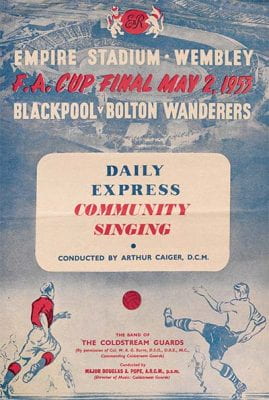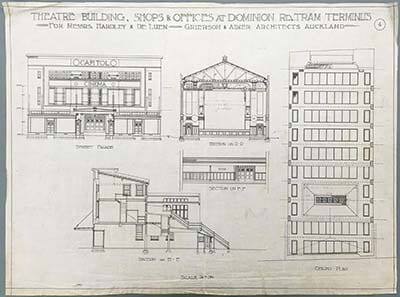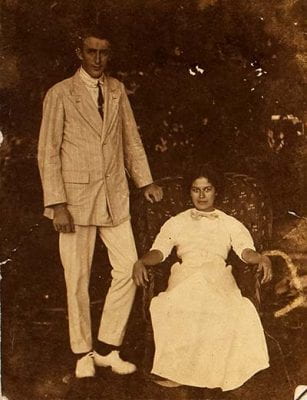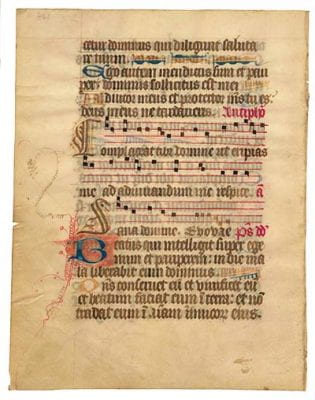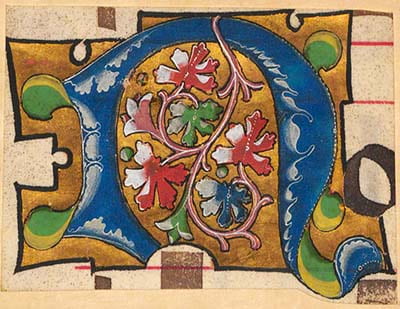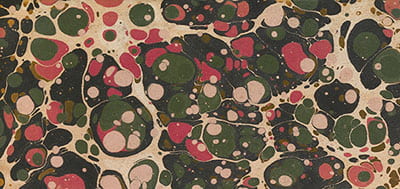Special Collections are privileged custodians of taonga housed in the stacks at Te Tumu Herenga. The staff share their five favourite items from 2021. Enjoy!
Cup final cheer
Major sporting events in 2021 were held behind closed doors without the sound of cheering spectators, notably during the Tokyo Summer Olympics. This communal song-sheet from the 1953 FA Cup Final held at London’s Wembley Stadium is a reminder of how supporters turn a sporting contest into a memorable event.
The words to 20 anthems, hymns and popular songs were printed in the brochure for the hour’s length performance before kick-off, including ‘She’s a lassie from Lancashire’ marking the final between two clubs from the county. Two copies were unearthed in a scrapbook kept by Labour politician and diplomat Sir William Jordan. Jordan was in London in 1952-53 to receive his knighthood and attend the coronation of Queen Elizabeth. I want to believe that Jordan also attended the football match, regarded as the greatest final of the 20th century, and took part in the community singing.1 – Ian Brailsford
Classical Capitol
Auckland’s recent move out of lockdown means we can enjoy going to the cinema again. Grierson and Aimer’s elegant design for the Capitol Cinema on Dominion Road is just one of the theatres represented in the Architecture Archive.2
When it opened in 1923, during a surge of new theatres, it was claimed to rank amongst “the most up-to-date in the Dominion”.3 Named after the Temple of Jupiter in Rome, the Capitol still operates as a cinema, albeit with a few modifications. It continues to offer the same opportunity for an hour or two of escapism as it did when it first opened almost a century ago. – Sarah Cox
Passport photographs with a difference
I recently added the details of more than 300 Tongan passport applications submitted to the British Consulate in Nuku’alofa, Tonga between 1916 and 1926 to the Manuscripts and Archives catalogue. This additional information makes them more accessible to family historians.
Many applications include photographs, most of which would fail current criteria for modern passports. One of my favourites is this photograph of Jack and Laura Protheroe (nee Skudder) who applied for a passport to travel to Auckland in January 1919 with their two young daughters, Rosary and Eugenie.4 – Katherine Pawley
Revealing words of praise
During the August-November 2021 lockdown, I was able to continue with the task of identifying several medieval illuminated manuscript fragments. These were donated to Special Collections in 2008 by Frank Horlbeck, a visiting professor of art history from the University of Wisconsin-Madison.5 The small collection is made up of seven fragments, and four of these have so far been identified with the assistance of Dr Nicholas Thompson from the Department of Theological and Religious Studies.
Above is a leaf from a 15th century liturgical psalter, depicting verses from Psalm 40 (verses 17-18) followed by an antiphon (short chant).
In this second selection, the initial ‘N’ is likely from a mid-15th century Italian antiphonary (book of music for a choir).
Illuminated manuscripts, such as psalters and choir books were produced in Christian monasteries throughout Europe, and, from the late 14th century onwards by professional scriptoriums. They were often owned by parish priests and were commonly found in churches during the later Middle Ages. Because of the volume in which they were produced, liturgical manuscripts are the most likely to have survived to the present day. Unfortunately, to increase profits, antiquarian book dealers frequently broke up bound manuscripts and sold individual leaves and fragments such as these separately.6 – Nigel Bond
Marbled end-leaves
It’s always a treat to find gorgeously decorated end-leaves bound into our rare books. One style that we often come across are British and European marbled papers from the 18th and 19th centuries. This example of ’stone’ marbling is in The life of Alexander Pope from 1769.7
Hand-marbling essentially involves floating colour pigments on a liquid and placing paper on top to absorb the patterns made by combs, styluses and other tools. An important industry for centuries in many countries, the craft has enjoyed a revival after mechanisation gained the upper hand in the 19th century.8
An object of study across several disciplines, end-leaves have also more recently attracted a wide audience of enthusiasts through social media. – Jo Birks
References
1 Sir William Jordan papers. MSS & Archives A-178, 2/3.
2 Theatre [Capitol Cinema], shops and offices at Dominion Road tram terminus for Messrs Hardley and De Luen. Geoffrey R. Land papers. MSS & Archives Arch 2020/4/31.
3 ‘New picture theatre’. (1923, August 18). New Zealand Herald, p.11.
4 Western Pacific Archives. MSS & Archives 2003/1, BCT 4, Item 1/4/25.
5 Frank Horlbeck collection of illuminated manuscript fragments. MSS & Archives 2021/11.
6 Hollis, S., & Barratt, A. (2007). Migrations: Medieval manuscripts in New Zealand. Newcastle, UK: Cambridge Scholars.
7 Ruffhead, O. (1769). The life of Alexander Pope, Esq. London: Printed for C. Bathurst. Glass Case 821.53 Vru.
8 Wolfe, R., & Berger, S.E. (2018). Marbled paper: Its history, techniques, and patterns, 2nd ed. New Castle, Delaware: Oak Knoll Press.

